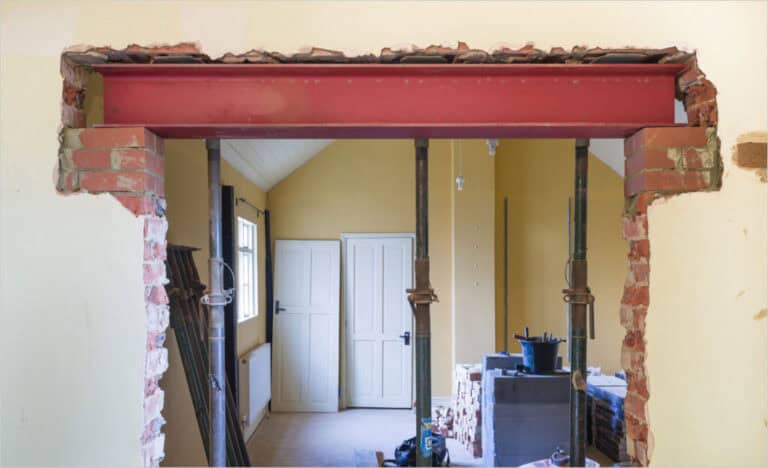If you’re in the construction industry, it’s vital to understand steel columns. They’re the foundation of your project’s stability. Choosing the right type of steel column can save you time, money, and headaches down the road. It’s not merely about complying with building codes; it’s about constructing a safe, efficient, and enduring structure.
We’ll explore the various types of steel columns, their unique characteristics, and their applications in construction. By the end, you’ll have a clear understanding of how to choose the right steel column for your project, ensuring it’ll be strong and durable for decades to come.
What is Steel Column?
A steel column is a vertical structural element made of steel that is designed to transfer loads from the upper parts of a building (such as beams, floors, and roofs) to the foundation. They are designed to withstand tremendous weight and force, ensuring that the structure remains stable and safe, and are commonly used in buildings, bridges, and other large structures.
Steel columns can be designed as slender columns (tall and thin) or short, thick columns (used for heavy loads). In modular and prefabricated construction, steel columns are often part of the modular units that are pre-manufactured and then assembled on-site.
Materials of steel columns
Common materials for steel columns include carbon steel, alloy steel and stainless steel. Carbon steel is the most commonly used, with high strength, suitable for general buildings and bridges. Alloy steel has stronger corrosion resistance and bearing capacity, suitable for high-rise buildings and extreme environments. Stainless steel has excellent corrosion resistance and is suitable for humid, marine and chemical environments.
Common specifications of steel columns
The specifications of steel columns vary. The following are several common types and application scenarios:
Square Tube: Excellent torsion resistance, suitable for building frames and curtain wall support structures, such as 100×100×5 mm square tube columns.
H-beam: wide flange, strong bearing capacity, suitable for high-rise buildings and large-span structures such as bridges and industrial plants. Common specifications include H200×200×8×12 mm.
I-beam: suitable for structures that bear vertical loads, such as floor support beams, frame columns, etc. Typical specifications include I200×100×7×10 mm.
C-Channel: Lightweight, suitable for secondary structural support, such as roof purlins and wall keels, with specifications such as C100×50×20×2 mm.
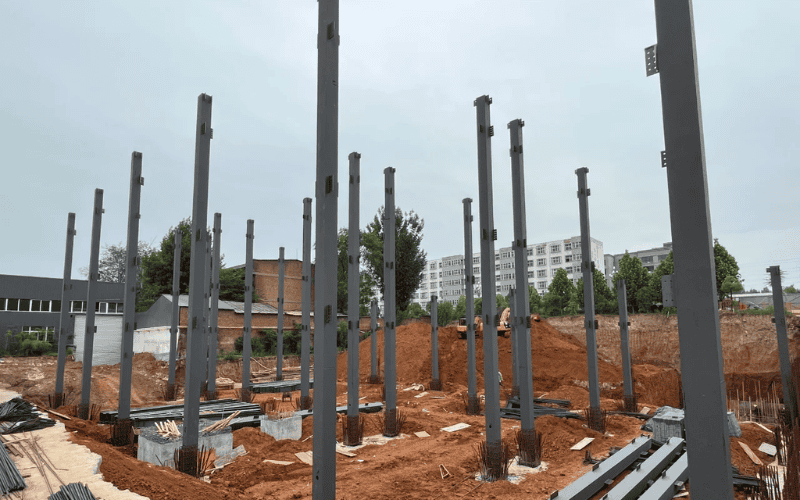
What are the Different Types of Steel Columns?
| Classification | Types |
| Based on Load-Bearing Capacity | – Short Columns |
| – Long Columns | |
| – Intermediate Columns | |
| Based on Shape and Section | – Solid (Rolled) Sections: I-beams, channels, angles, t-shape columns. |
| – Hollow Sections (Box columns): Rectangular or circular. | |
| – Built-up Sections: Assembled from steel plates or angles. | |
| Based on Function | – Compression Columns |
| – Axially Loaded Columns。 | |
| – Bending Loaded Columns | |
| Based on Connection and Support | – Pinned Columns |
| – Fixed Columns | |
| – Cantilever Columns | |
| For Seismic Applications | – Base-Isolated Columns |
| – Seismic-Resistant Steel Columns |
1. Metal Building Column Types Based on Load-Bearing Capacity
Short Columns: These are columns that are relatively short compared to their lateral dimensions and typically experience compressive forces. Short columns are designed to carry axial loads without significant lateral instability.
Long Columns (Slender Columns): These columns are taller and have a higher length-to-width ratio. They are prone to buckling and require more detailed design considerations, often using the effective length factor or slenderness ratio for stability.
Intermediate Columns: These columns fall between short and long columns in terms of their slenderness ratio. The design requires careful consideration of both axial load and buckling resistance.
2. Types of Structural Steel Columns Based on Shape and Section
Solid (Rolled) Sections: These columns are made from a single piece of steel, typically in the form of I-beams (wide flange beams), channels, or angles. They provide excellent strength and stability for a wide range of applications.
Hollow Sections (Box Sections): Hollow steel columns, including rectangular or circular sections, are commonly used in modern design because they are lighter and have a higher strength-to-weight ratio. They also offer superior resistance to torsion.
Built-up Sections: These are columns made by welding or bolting together individual pieces of steel, such as plates or angles. Built-up sections are commonly used for large structures where standard shapes may not provide the necessary strength or size.
3. Types of Steel Building Column Based on Function
Compression Columns: These are the most common type of steel column, designed primarily to carry compressive loads. They are found in most building structures, such as high-rise buildings, bridges, and industrial facilities.
Axially Loaded Columns: These columns experience loads along the axis of the column. The design for these columns primarily focuses on resisting axial compression and ensuring stability.
Lateral-Torsional Buckling Columns: These columns are subjected to combined axial and bending loads, making them vulnerable to lateral-torsional buckling. They require more advanced design methods, including lateral bracing or the use of stronger steel grades.
4. Types of Steel Structure Columns Based on Connection and Support Conditions
Pinned Columns: Pinned at both ends, these columns are designed assuming no moment transfer at the column ends, and they primarily carry axial load. The buckling behavior of these columns is based on their effective length.
Fixed Columns: Fixed at one or both ends, these columns experience both axial load and bending moment. The increased moment capacity reduces the effective length and provides greater stability against buckling.
Cantilever Columns: These columns are fixed at one end and free at the other, often subjected to bending in addition to axial load. This type of column needs to account for both axial compression and bending in the design.
5. Innovative Prefab Columns for Seismic Applications
Base-Isolated Columns: In earthquake-resistant designs, columns may be designed with base isolators that allow movement during seismic events. These isolators help absorb shock and reduce the forces transmitted to the structure.
Seismic-Resistant Steel Columns: Columns designed to absorb seismic forces effectively often include additional bracing, energy-dissipating devices, or advanced materials that enhance their resistance to lateral forces during an earthquake.
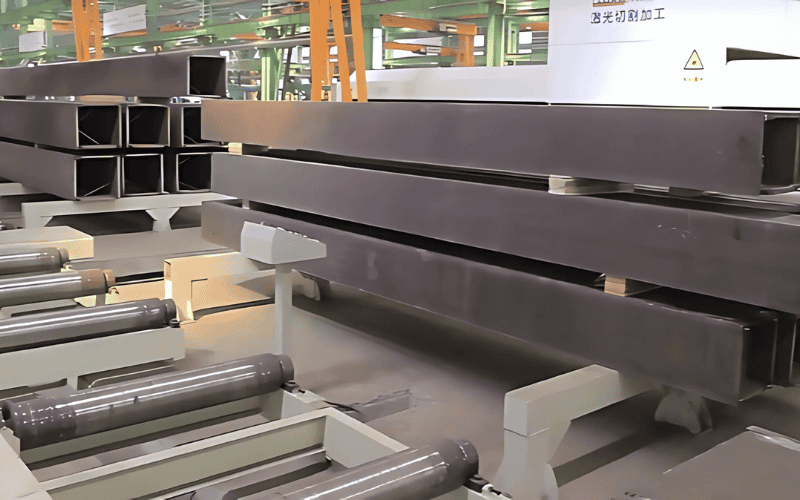
Manufacturing and processing technology of steel columns
The manufacturing of steel columns includes key steps such as rolling, welding, cutting, drilling, and coating. Hot-rolled steel columns are formed by high-temperature rolling and have good strength and uniformity, while cold rolling provides higher dimensional accuracy.
Welded steel columns (such as H-shaped welded and box-shaped columns) are suitable for large load-bearing requirements, but the manufacturing cost is high. In contrast, rolled H-shaped steel has a fast production speed and is suitable for standardized construction.
Surface treatment is a key link in the anti-corrosion of steel columns. In marine, chemical, and high-humidity environments, galvanizing or weathering steel treatment can effectively extend the service life, while painting can provide basic protection. Reasonable manufacturing and surface treatment processes can improve the durability and adaptability of steel columns.
Installation and maintenance of steel columns
The installation of steel columns includes steps such as transportation, lifting, and fixing. It is necessary to ensure accurate docking to avoid installation errors. Safety measures should be taken during construction, such as using anti-fall equipment and controlling the lifting load to reduce the risk of accidents.
In terms of maintenance, the anti-corrosion layer, fasteners and welds need to be checked regularly to prevent rust and structural degradation. In high-temperature environments, fire-resistant coatings or refractory materials can be added to improve fire resistance and ensure long-term safety.
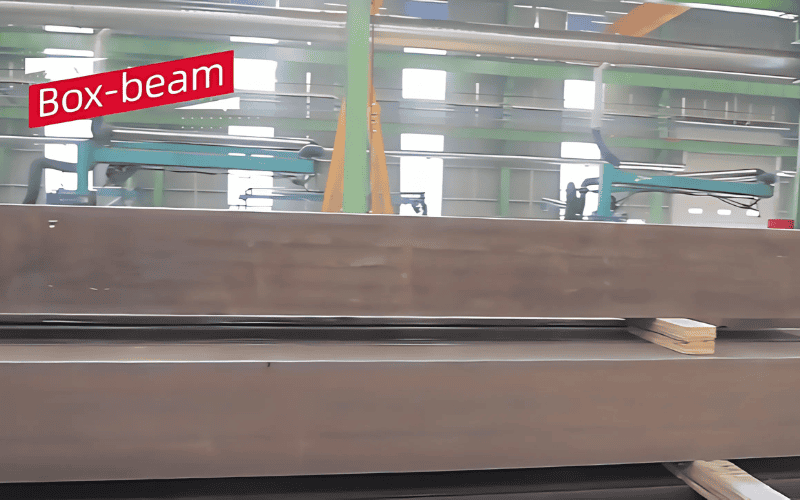
Principles of Layout of Steel Columns in Steel Structures
In steel structure design, it is crucial to arrange steel columns reasonably to ensure the stability, load-bearing capacity and economy of the structure. The following are key layout principles:
Building space and use requirements: The layout should meet the functions of indoor space, such as avoiding main passages, elevator shafts, and lighting areas to ensure convenience of use.
Load requirements: Calculate the required load capacity based on the building function, floor and use. Ensure that the column can withstand the expected load (self-weight, live load, wind load, earthquake) and maintain stability. Select the column type accordingly – short columns bear axial loads, and long columns require buckling analysis.
Section type selection
- Solid sections (I-beams, channel steels) are suitable for light loads and small spans.
- Hollow sections (circular, rectangular tubes) provide high strength and lightness for large spans.
- When needed, built-up sections can be welded for added strength.
Buckling and stability: Long columns are susceptible to buckling, depending on their length, shape, materials, and bracing. Use effective length factors to ensure stability. Short columns focus primarily on axial load capacity.
Steel type selection: Choose based on strength, corrosion resistance, and fire resistance—options include carbon steel, low-alloy steel, and high-strength steel.
Fire protection: Fire weakens steel; apply fire-resistant coatings or cladding to maintain structural integrity in high-temperature environments.
Seismic design: In earthquake-prone areas, improve seismic performance with buckling-restrained braces or dampers to enhance durability.
Cost and construction feasibility: Balance material and labor costs. Prefabricated or standard steel sections can reduce expenses and simplify installation.
Environmental suitability: Use corrosion-resistant steel or coatings in wet/marine areas. Consider thermal expansion and contraction in extreme temperatures.
Comply with standards: Ensure compliance with AISC, European, and Chinese building codes to ensure structural safety and performance.
If you need expert guidance on how to choose the right steel columns, feel free to contact us!
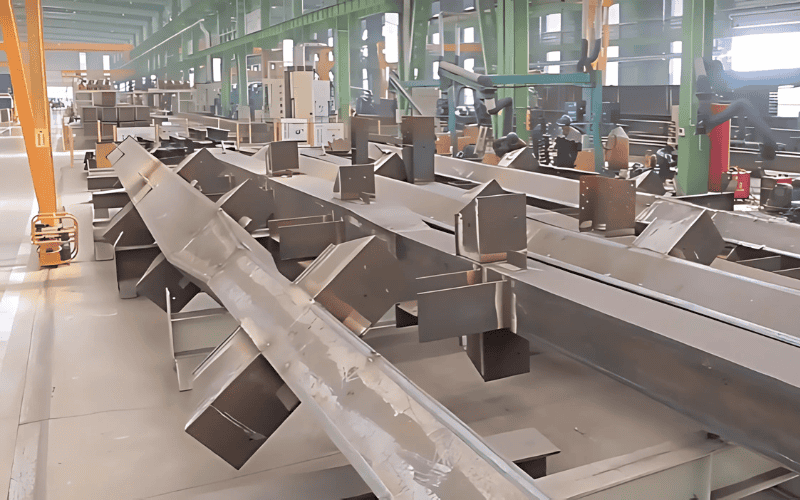
What is use of steel columns?
Steel columns are essential components in construction, offering strong and flexible solutions for structural support across construction projects such as high-rise buildings, industrial structures, and bridges.
In high-rise building construction, steel columns are most commonly used to support the building’s frame, providing stability and strength to withstand the loads of floors and roofs.
Steel columns are also used in bridge construction for supporting the structure and distributing the loads.
In industrial construction, steel columns are often used in warehouses and factories where large, clear spans are required. The usage of steel ensures that these columns are both durable and able to handle heavy loads, making them suitable for the variety of construction types found in industrial applications.
In addition, steel columns are used in commercial buildings, where they provide strong support for large, open floor plans.
FAQs
Which steel is best for columns?
Carbon steel is predominantly utilized for columns owing to its robust strength and cost-effectiveness. In more severe environments, stainless steel or alloy steel may be employed to enhance corrosion resistance.
What is the best shape for a steel column?
The best shape depends on the application, but I-beams (H-beams) are most commonly used for their strength and efficiency. Round tubular columns are also a good choice for high-strength, compact designs. Whatever shape you need, we can provide it,
How thick should a steel column be?
The thickness of a steel column depends on the load it needs to support. Typically, the thickness ranges from 1/4 inch to several inches, but the exact size should be calculated based on the load requirements and safety factor. Please consult our structural engineers for exact specifications.
What is the difference between a steel beam and a steel column?
Columns support loads vertically, transferring weight to the foundation, while beams span horizontally, supporting loads across space. Both are integral to a building’s structural integrity, but they play different roles.

